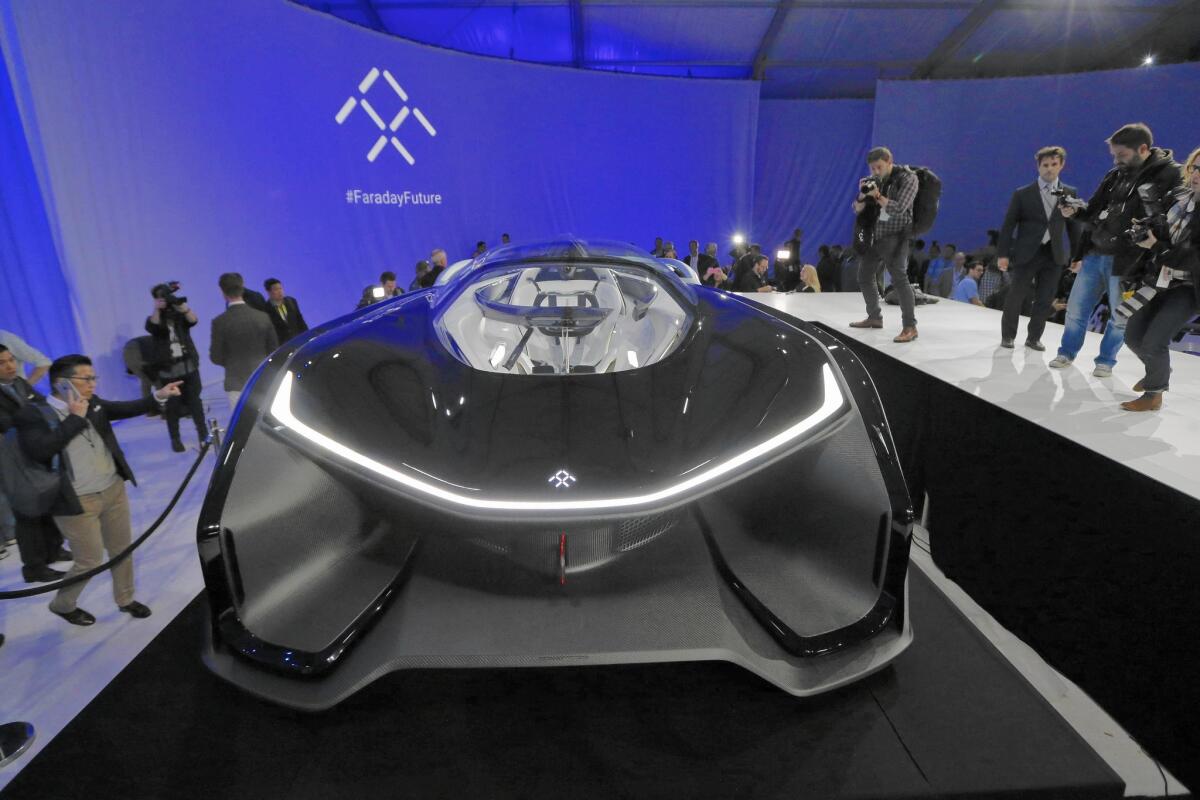Faraday Future and Snapchat stand to gain millions in state tax breaks for adding jobs

- Share via
Electric car start-up Faraday Future Inc. and mobile app maker Snapchat Inc. are poised to receive millions of dollars in state tax breaks over the next five years if they can hit hiring and investment goals.
Chinese billionaire Jia Yueting’s Faraday Future would get a total of $12.7 million in credit toward corporate income taxes for meeting requirements set with the state, including adding almost 2,000 workers in Gardena and elsewhere in California by 2020.
Snapchat could receive a $1-million credit annually for the next five years for having 1,560 employees at its Venice headquarters by 2020, up from more than 600 now.
The awards are among the most lucrative in the latest round of the California Competes Tax Credit program, launched in 2014 to boost employment across industries statewide. The new awards to Snapchat, Faraday Future and 101 other companies still must be approved by a state committee, which is scheduled to meet Thursday. But over the last two years, the panel has rejected just two agreements while approving 330 others.
It isn’t clear how effective the young program has been since becoming one of the replacements for the controversial enterprise zone system, which sought to stimulate development in economically depressed neighborhoods but was criticized as a giveaway to large employers that didn’t need the help.
At least some companies say the new credits have led them to think more aggressively about California expansions.
“We were debating what we should do to have a bigger presence in California,” said Philip Krim, chief executive of Casper Sleep Inc., a retailer of mattresses backed by more than $70 million in venture capital and other investment. “And this is one of the things that made us feel confident about making the investment.”
If approved next week, Casper, which has recorded sales totaling $100 million since 2013, would get $272,000 in credits during the next five years for expanding its California workforce to 50 from about 20.
The tax break would enabled the company to double hiring projections for California, Krim said. Its workforce includes designers and engineers working on the mattress and other products in the San Francisco Bay Area and sales and marketing employees in Los Angeles. About 130 are employed in New York, where it is headquartered.
As it begins to put the new plans in place in the coming weeks, Casper will open an office and showroom on Venice’s upscale Abbot Kinney Boulevard, while shutting down a showroom in Hollywood Hills.
Other start-ups declined to comment, including Snapchat and augmented reality firm Magic Leap, which has agreed to hire 141 people in Mountain View and Santa Monica in exchange for a $3.3-million credit.
State officials receive hundreds of applications for every new batch of credits. But they give preference to companies that have the biggest hiring and investment plans relative to the size of the tax break sought. Also weighed are salaries and indirect effects for the rest of the economy. Some of the money is set aside for smaller businesses.
But three companies have accounted for almost 20% of the $211 million awarded, led by electric car maker Tesla Motors Inc. at $15 million. The others are aerospace giant Northrop Grumman Corp. and technology manufacturer Samsung Electronics Co. Nordstrom would join the big beneficiaries if an $11-million credit for the retailer to hire distribution-center workers in the Central Valley is approved.
But Faraday Future, the electric car maker that intends to rival Tesla, would be the new No. 2.
Faraday Future has about 600 workers at a former Nissan sales office in Gardena, a company spokesperson said. A much smaller number of engineers are working out of a tech facility in San Jose.
Thanks in part to $216 million in tax incentives, the company selected Nevada as the site of its planned $1-billion factory.
But in an application for California tax credits, the company said it would continue to hire in California, including at a spot in Rancho Dominguez that will be used to build vehicles for testing, spokesperson Stacy Morris said.
To qualify for the funds, Faraday Future would have to reach 868 employees this year and 2,226 by 2020. Those employees would earn a minimum of $45,000, and a groupwide average of $125,000.
Faraday Future’s spending on equipment, offices and other investments would be $50.2 million in 2016 and $84.3 million in 2017, the company told the state. Its total investment from 2016 to 2020 would be more than $311 million.
The tax credits would kick in during the 2019 tax year, with a $2-million tax break. It would get a $10.7-million tax credit the next year.
The company has not declared when it will bring its first car to market — or what it will be named. But Morris promised a “premium electric vehicle” with “industry-leading range” when it rolls out in the “next couple of years.”
State tax officials will track whether the companies hit targets. So far, a pair of companies have lost out on small amounts. A much bigger, $1-million return is up for approval next week after pharmaceutical giant Novartis said it scaled back California plans.
ALSO
Three reasons why Verizon would be a good suitor for Yahoo
Criminal hackers now target hospitals, police stations and schools
Meet the man behind the idea for a branded basketball court at Runyon Canyon Park
More to Read
Inside the business of entertainment
The Wide Shot brings you news, analysis and insights on everything from streaming wars to production — and what it all means for the future.
You may occasionally receive promotional content from the Los Angeles Times.












